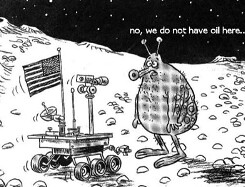 The International Energy Agency‘s long awaited World Energy Outlook 2008 report has been published. You can read the executive summary here.
The International Energy Agency‘s long awaited World Energy Outlook 2008 report has been published. You can read the executive summary here.
Over the past year the IEA has been reviewing the production figures and reserve data of the worlds oil fields. Once a skeptic of Peak Oil it is now warning of a severe supply crunch without major new investment. Fatih Birol, chief economist of the International Energy Agency (IEA), has said that fresh sources of oil equivalent to the output of four Saudi Arabias will have to be found simply to maintain present levels of supply by 2030.
As reported in the Times non-Opec countries, such as the United States, Britain and Mexico, are experiencing depletion rates of 10 to 11 per cent per year. The average across the 13 member countries of the Opec cartel, which produces 40 per cent of the world’s oil, was lower, at about 2 to 3 per cent. Whilst over-optimistic about the potential for tar sands, oil shale and coal-to-liquids to fill the supply gap, the IEA report breaks new ground by highlighting the depletion in existing fields and pointing out that “Preventing catastrophic and irreversible damage to the global climate ultimately requires a major decarbonisation of the world energy sources”.
Below is the opening paragraph of the report:
“The world’s energy system is at a crossroads. Current global trends in energy supply and consumption are patently unsustainable — environmentally, economically, socially. But that can — and must — be altered; there’s still time to change the road we’re on. It is not an exaggeration to claim that the future of human prosperity depends on how successfully we tackle the two central energy challenges facing us today: securing the supply of reliable and affordable energy; and effecting a rapid transformation to a low-carbon, efficient and environmentally benign system of energy supply.”

[…] view on the report (see more here) is that it is a mixture of blind optimism and dire warnings. It was probably written by several […]